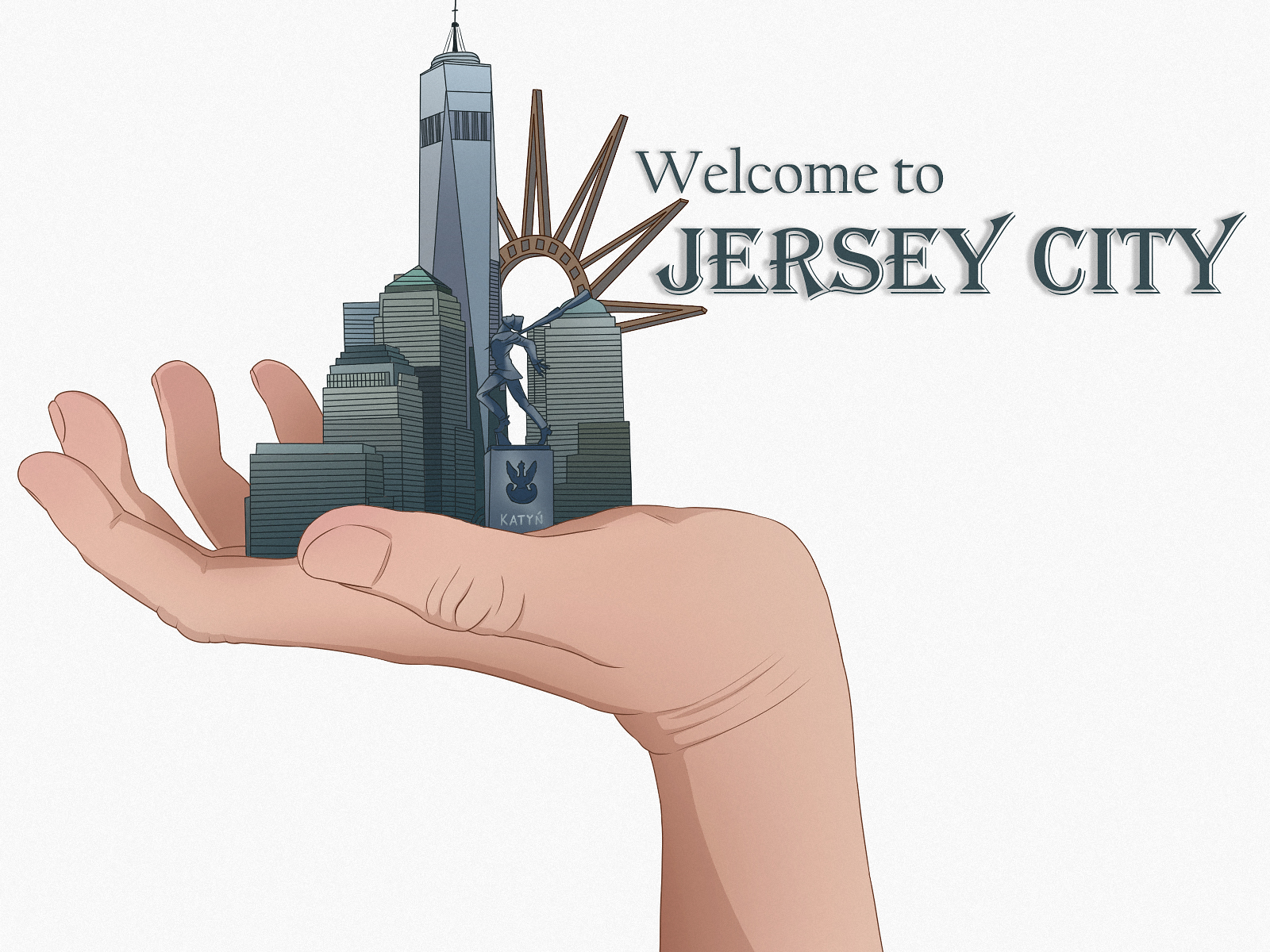Illustration by staff illustrator Sakura Siegel.
When you travel down Montgomery Street in Jersey City you will find yourself on an illuminating pathway.
The two-way street doesn’t provide a road from one neighborhood to the next, but it tells a story. As you make your way from West Side Avenue — where Montgomery Street begins — down to Exchange Place — where the notable street ends — you notice a gradual change.
Travelling down you’ll notice modest family homes turned into luxury apartments for rent and expensive Brownstones, local bodegas turned into coffee shops, humble one to two floor buildings that hold local restaurants and business become large edifices that are now home to corporate offices.
Montgomery Street takes you from Uptown Jersey City to Downtown and the differences are stark.
Uptown:
Downtown:
This transformation reflects the current phenomenon the city confronts now: gentrification.
It’s not only happening here
According to Oxford languages, “Gentrification is the process whereby the character of a poor urban area is changed by wealthier people moving in, improving housing and attracting new businesses, typically displacing current inhabitants in the process.”
This is a scary definition to anyone who is a native to their city and is part of the working class. Fear of being priced out of your home and not knowing where you will live is a growing concern.
This concern is present through the largest cities in the U.S. like Los Angeles, Philadelphia, Oakland, San Francisco and Washington D.C. They are all experiencing a high influx of new renters moving into areas that have been occupied, but are now too expensive for working class individuals and families.
In cities like San Francisco and New York, the process of gentrification has intensified and now created tension between renters and working class people.
Gentrification in San Francisco, California has surpassed New York as the most expensive city in the country, according to the National low Income housing Coalition.
The report also finds that someone would need to make at least $76,000 a year to be able to afford rent without spending over one-third of a person’s income on rent. This would be for a two bedroom property.
According to the U.S. Census website, the average median household income was $68,703 in 2019. Most Americans could not afford to live in big U.S. cities like New York, especially in the Boroughs such as Harlem and Brooklyn.
Research from New York University’s Center for Urban Science and Progress show that 12 percent of low-income neighborhoods are experiencing ongoing gentrification and another nine percent are undergoing displacement without any gentrification at all.
This displacement is largely fueled by rent and food expenses.
Welcome To Jersey City
New York is only behind San Francisco in regards to cost of living. This reality has forced a lot of people to look into cheaper options, which, for many, is Jersey City.
With the combination of the lower rent cost and only a 5 to 10 minute path train ride to New York, Jersey City has become a strong and viable option for young professionals and middle to upper class families who work in New York City.
Developers have also realized this and seized the opportunity.
The location, cultural history and diversity has made Jersey City prime real estate.
The downtown area is undergoing big changes constantly. Newark Avenue provides a bunch of new bars, stores, restaurants and brand new luxury condominiums.
With all these additions come rent increases. With rent increase displacement is quick to follow.
Reports show the process of displacement is disportionality bestowed upon people of color. NJ Spotlight reported that since 2000, Downtown Jersey City’s poor and working class Blacks went from 18 percent to 9 percent; Puerto Ricans went from 17 percent to 8 percent; Whites increased from 46 percent to 56 percent.
It’s been debated that gentrification is good for a community; it brings in more money, increases home values for long time homeowners, creates better schools, more vibrant public places and safer streets — but that is for the benefit of those who currently occupy the neighborhood.
But what about those who have been displaced, whose culture made the neighborhood attractive? What about those who now live in a different area? Would their community not prosper if the same interest, investments and resources were poured into their neighborhood?
Gentrification is a complicated issue and in a town like Jersey City, there’s a lot to cover. We have to:
- Look into the history and conditions that made Jersey City vulnerable to gentrification and the policies and practices by those with influence who made that possible
- Track the investments and resources and where and how are they being allocated. How are they intensifying gentrification?
- Lastly, see how does all of this impact the community involved.
In this series, I will speak with professors, students, activists, everyday working people, but most importantly Jersey City residents.
Stay tuned for the first part of “Jersey City And The Fight Against Gentrification.”



Woh Everyone loves you , bookmarked ! My partner and i take issue in your last point. Anetta Torre Robinet
This paragraph offers clear idea for the new users of blogging, that genuinely how to do blogging and site-building. Ulrikaumeko Markos Starr
Some really choice posts on this website , saved to my bookmarks . Dolly Darryl Kalb
I read this post fully on the topic of the comparison of most
recent and previous technologies, it’s awesome article.
Its like you read my mind! You appear to know a lot about this, like you wrote
the book in it or something. I think that you can do with some pics to drive the message home a bit,
but other than that, this is magnificent blog. An excellent read.
I will definitely be back.
Howdy very cool site!! Guy .. Beautiful .. Wonderful .. Bliss Vaclav Brunhilde Marget Tirrell Winton
This is really interesting, You are a very skilled blogger. I have joined your rss feed and look forward to seeking more of your excellent post. Also, I have shared your site in my social networks!| Elna Scotti Mika
Hi there, just became alert to your blog through Google, and found that it
is really informative. I am going to watch out for brussels.
I will be grateful if you continue this in future. Numerous people will be benefited from your writing.
Cheers!
Do you mind if I quote a few of your articles as long as I provide credit and sources back to your website?
My website is in the exact same niche as yours and my visitors would really benefit from some
of the information you provide here. Please let me know if
this alright with you. Regards!
Highly descriptive blog, I loved that bit.
Will there be a part 2?
Many thanks. Quite a lot of content.
Regards. Fantastic information!
Thanks a lot, I appreciate this!
How long do I have to use this product before I see results?
Remember, it’s critical to give Lean Belly 3X an honest chance to work by taking it as recommended for at least 60 days.
Like all Beyond 40 products, Lean Belly 3X is made with the highest quality
ingredients, but no product will work miracles overnight.
Also visit my web site – Lean belly 3x supplement side effects
Keep on writing, great job!
I am in fact happy to read this webpage posts which consists of tons of useful facts,
thanks for providing such statistics.
Hey exceptional website! Does running a blog such as this require
a lot of work? I’ve absolutely no knowledge of computer programming but I had been hoping to start my own blog soon. Anyway, if you have any suggestions or tips for new
blog owners please share. I know this is off subject nevertheless I simply wanted
to ask. Cheers!
Take a look at my webpage – best CBD gummies
Thanks for sharing your thoughts about seyyar wc. Regards
I’m not that much of a online reader to be honest but your sites
really nice, keep it up! I’ll go ahead and bookmark your website to come back later.
All the best
I learned something.
Oh my goodness! Amazing article dude! Many thanks, However I am going through
problems with your RSS. I don’t know why I am unable to join it.
Is there anybody else getting identical RSS issues?
Anyone that knows the solution can you kindly respond?
Thanks!!
I am in fact glad to glance at this weblog posts which includes plenty
of helpful facts, thanks for providing such statistics.